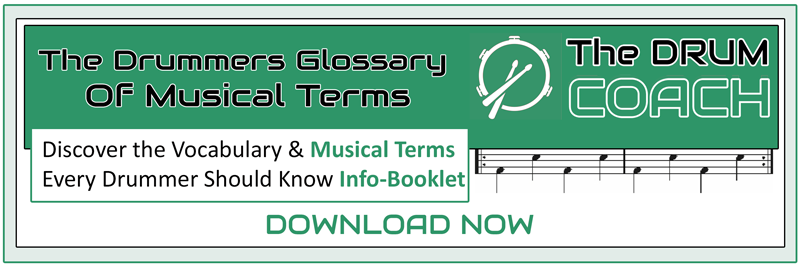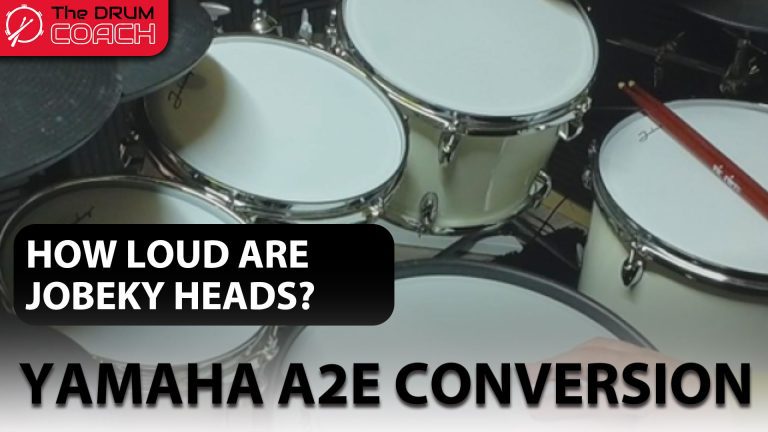Reading drum music or drum charts as they are most commonly called is a simple process once you understand the fundamentals of how to read drum music. Once you have learned the basic theory involved in reading drumming notation. Along with the basics of how to read drum rudiments, and how to interpret them.
In essence, reading a particular drum chart is a matter of:
- Knowing the different parts of the drum kit
- Understanding the symbols that represent each part of a drum kit
- Understanding the drumming notation and basic drumming theory
- Knowing the directions (the map) to follow within the piece of drumming music
It is then the drummer’s job to listen to the music. To read and follow the drum chart (or map), and then interpret that drum chart in one of two ways.
First, the drummer can play what is written exactly and nothing more. If that’s what the band leader and music need. Or, add embellishments to what is written within the drum chart to enhance the music. Through a unique interpretation of what is written down in that drum chart.
The Basics of How To Read Drum Music
Learning how to read drum music is (in my opinion) a very important skill for any drummer. It enables him to learn different beats, rhythms, phrases and fills more efficiently. And it also allows him to learn songs fast.
Your progress as a drummer can be limited if you don’t know the basics of reading drum charts. This includes, as already suggested, symbolism, notation, and direction (the map).

When reading drum music, keep in mind that the notes on the staff correspond to different components of the drum set. The bass drum, snare drum, hi-hats, ride cymbal, crash cymbal, and tom-toms. It’s crucial to understand this fundamental.
The snare drum is commonly notated with a filled-in note in the second space of the staff. The hi-hat is denoted by an X symbol on the top line, while the ride cymbal is represented by an X symbol as well.
It is usually indicated whether to use the ride cymbal or to use the hi-hats. Because they are both often written resting on the top line of the staff. This is done through text saying either hi-hat or cym.
These are only the symbols that represent each drum. Which are then used in combinations and or phrases and beats that are written within the 5 lines (staff). You can see this in more detail here.
Timing Is Everything
Besides learning how to read drum symbolism and notation, it is also important to know how to count time. At the start of a musical piece, time signatures are specified to indicate the rhythmic structure and beats per measure. And they tell you how many beats there are in a measure (bar) of music.
The most common time signature is 4/4. The first 4 is indicative that there are 4 beats in a measure or each bar of music. The second 4 tell us what kind of notes they are. In the case of 4/4, the notes are quarter notes. For example, there are 4 quarter notes (or crotchets) within a bar of music. The quarter notes are played even throughout the music.
Once you understand the basic symbolism. And have learned how to understand and read drum notation as well as count time. You will be well on your way to becoming a reading drummer. With a little (or a lot) practice of course.
So let’s go back to the beginning and first learn…
The Different Parts Of The Drum Set
To avoid repeating the things I have written in other posts. I will add links to pages to explain in a more musical sense what is being said here. Don’t worry, it will become clear if you follow the links and read the presented information. The links will open in another window so you can keep track of where you are. And return here when you’re done reading the extra content.
The drum set is a versatile and essential part of any band. They consist of a bass drum, snare drum, one or more tom-toms, a ride cymbal, and one or more crash cymbals.

The bass drum is the largest and lowest-pitched drum, and it is usually placed in front of the drummer. It’s played with the right foot (the left foot if you’re left-handed). The snare drum is smaller than the bass drum and mounted on a stand between your legs. And central; it produces a sharp, crisp, metallic sound.
The tom-toms are also mounted on stands or on the bass drum. They come in different sizes and produce lower-pitched sounds than the snare drum.
Finally, the cymbals are placed on stands or attached to the bass drum. They produce a crashing sound when struck with a stick. Together, these drums and cymbals provide the rhythm for a wide variety of music. The drums and bass form the foundation of the music or rhythm section.
Reading drum notation
Anyone who wants to learn how to read drumming music must first understand how to read drum notation. Although it may seem daunting at first, drum notation is actually quite straightforward. Once you get the hang of it. The key is to start by breaking down the staff into measures. Then identify the notes that correspond to each drum as suggested before.
The notes will tell you which drum to strike at what time and in what order. Once you have an understanding of the basics, you can begin to decipher more complex patterns. In my book, The Rock Drumming Foundation, the first of 12 drum lesson books – I break this down even more. You can then learn the basics of reading music as you develop your basic drumming skills.
Then, with a little practice, you’ll be reading drum notation like a pro in no time.
Interpreting drum music
In short, drum music is a collection of musical notes. These notes use special symbols to show which drums and cymbals you should play. And when you should play them.
There are many different ways to interpret drum music, and each drummer has their own style. How the drum chart and music are interpreted is dependent on the skill level of the drummer. And how efficient his drumming is along with how to read drum rudiments. And to then interpret it. Yet there are some basic principles that can be applied to all drumming.
First, it is important to read the note values accurately. Depending on the time signature. Notes can be subdivided into either whole notes, half notes, quarter notes, or eighth notes. This is how you would count through the piece of drum music.
Second, it is important to understand the dynamics of the piece. The dynamic markings show how loud or soft the drums should be played. Get your free copy of the Glossary of Musical Terms using the form below for more on dynamic drumming terms.
Third, it’s essential that you follow the music from the beginning to the end. And as indicated by any repeated sections within the chart. So you can begin and end along with the other musicians.
Finally, it is important to stay in time with the other instruments. This can be challenging, but it is the number one priority for all drummers to develop a strong sense of timing.
With these basic principles in mind, anyone can begin to interpret drum music. at least within their own mind and understanding. Interpreting the actual playing of the drum chart, well, that’s another thing. But as with everything, practice moves you closer to the goal. Of reading and interpreting drumming music sheets.
Conclusion
It’s important to take into account the symbols and abbreviations used in drum charts. So get your copy of the Glossary of Musical Terms below to get you started. And over time, learn the musical abbreviations, especially the ones specific to drummers.
The key to interpreting drumming charts is to first identify the different elements. And how they’re represented.
The music staff, drums, symbols, and notes collectively form the essential elements for drum notation and representation. Followed by the time signature and note values, and finally the map of the music.
Once you have a basic understanding of these elements, you can begin to interpret the chart. The most important thing to remember is that a drum chart is not a score; it is only a guide for the drummer. As such, there is some room for interpretation. And you should feel free to experiment with different rhythms as you go.
With a little practice, you will be able to read drum charts with ease.
Do you already read drum charts? let us know your experiences in the comments below. and share your knowledge with other drummers that visit…




